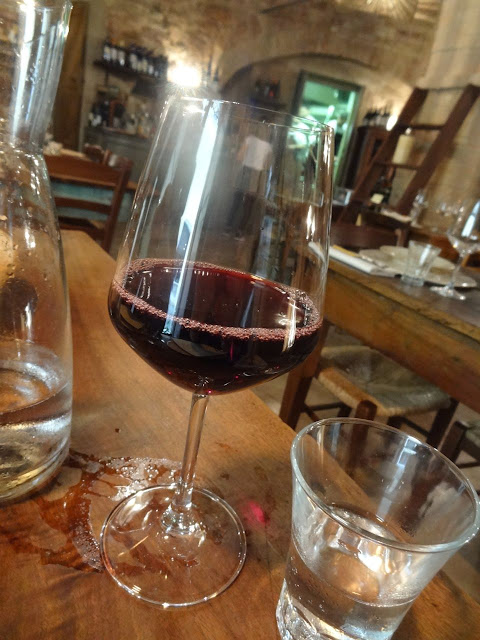Entering the ancient fortress walls of Spello one steps back in time, walking through medieval gateways, past Roman ruins and small shops that have been run by the same family for generations. Spello is all texture, with rose coloured stone walls, crumbling terracotta roof tiles, stone pathways, and weathered wooden doors. The splendidly intact town walls are draped around the centro storico like a necklace. Populated in ancient times by the Umbri, Spello became a Roman colony in the 1st century BC. 'Hispellum' was originally a Roman settlement – it lay on the Via Flaminia consular road, close to the strategic junction for Perugia. The most impressive remnant of this stage of the town's history, apart from the walls themselves, is the Porta Venere, an Augustan-era gate flanked by two 12-sided towers, standing in magnificent isolation on the west side of town. Most of the other sights are scattered along Via Cavour, the main street, beginning with Santa Maria Maggiore. This church has a finely sculpted medieval portal, but the real treat is inside: the Cappella Baglioni side-chapel is decorated by one of Pinturicchio's most joyous and colourful fresco cycles, painted in 1501 for the powerful Baglioni family and centred on the birth and childhood of Jesus. This native of Spello was nicknamed "the rich painter" because of the generous detail in his paintings. On Wednesdays, there's a wonderful Famers Market just outside the city walls, but Spello's other pleasure is the civilized pace of life of the town and the lovely Subasio marble from which it is built, which takes on a peach-pink hue around sunrise and sunset.
Plump red tomatoes at Spello's Wednesday farmer's market just outside the city walls
Luscious local purple artichokes, which we bought and roasted for dinner the following night
View down to the market from inside Spello's Medieval walls
A winding and vertical climb is characteristic of Spello
Some of the many flowers that dot the hill town
A small residential courtyard with pots of flowers
A shop festooned with flowers
Another path wends its way through Spello
Drinkable water can be found in most Italian hill town squares
A welcome sight...a lane way going downhill!
A 'gatto' appears to have spotted something quite compelling
A shop on Via Cavour sells lovely local salumi, cheese and olive oil
A view looking down Via Cavour, the main street in Spello
The people of Spello are all very friendly, with many taking the time to linger and share a story
Santa Maria Maggiore with 17th-century carved wooden doors
The interior was updated in 1656
The spectacular frescoes of the Cappella Baglioni with gorgeous majolica floor tiles from 1566
La Cantina, one of the finer and more picturesque restaurants in Spello
The lovely stone interior of La Cantina
The delicious menu features typical Umbrian dishes and fine local Montefalco wines
A basket of warm house made bread
Our server uncorking a bottle of local red wine
Full bodied and absolutely delicious
Affettati of local cured meats, farro salad, papa al pomodoro and polenta
Crostini with paté di fegato and also crushed chickpeas with a drizzle of olive oil,
a specialty of Spello
Pollo al Diavolo with fresh rosemary and arugula
Braised Spinach
Fluffy roasted 'patate al forno'
A single espresso to finish the meal
Sformatino di Patate e Porcini
Serves 6
Recipe courtesy of Chef Valeriano Federici, La Cantina
1 lb red Colfiorito potatoes, peeled and diced
2 oz white Cannara onions
1/2 lb fresh porcini mushrooms , finely sliced
1 oz Extra virgin olive oil
1/2 cup double cream
1 oz grated parmesan cheese
3 egg whites
1 oz vegetable broth powder
Sauce:
4 cups double cream
4 cups dairy milk
5 oz fresh ricotta cheese
5 oz grated parmesan cheese
2 oz fresh Black truffle
Salt to taste
Extra vergin olive oil, for garnish
Pour the olive oil in a heavy bottomed stainless steel pot. Add the finely chopped onion and allow it to soften, then add the potatoes and close the lid and simmer, stirring occasionally, until they are partially mashed. Add a little hot water if the mixture is too dry. Add the finely sliced mushrooms and finish cooking for about 20 minutes, remove from heat and let cool slightly. Then combine the remaining ingredients, stirring with a spoon to make the mixture homogeneous. Pour the mixture into circular single-dose aluminum moulds, sprayed with the oil and bake in a water bath for about 25 to 30 minutes at 350°F until they have taken firmed up and lightly browned. While the flans are baking, pour the milk and cream in a steel saucepan, then add the combine ricotta and Parmesan and warm up on a low heat. Use an immersion mixer to create a smooth sauce, and add half of the finely grated truffle and a pinch of salt. Keep warm until ready to serve. Remove the flans from the oven and while still hot, place them individually on a warmed dish, cover completely with the sauce and serve very hot, garnished with the remaining fresh truffles, thinly sliced, and olive oil.
































No comments:
Post a Comment